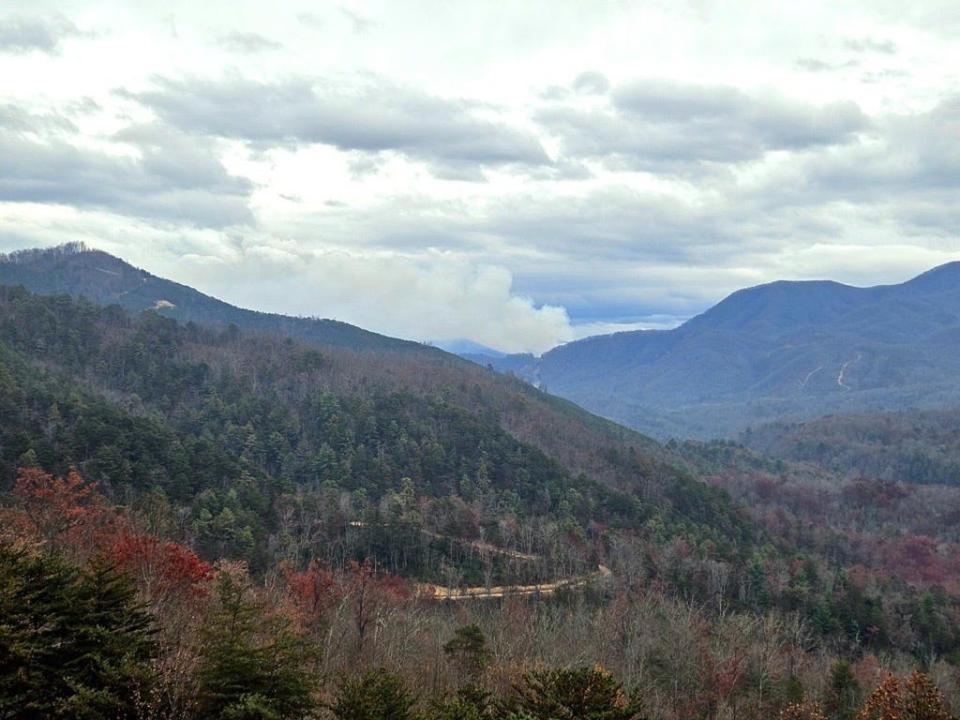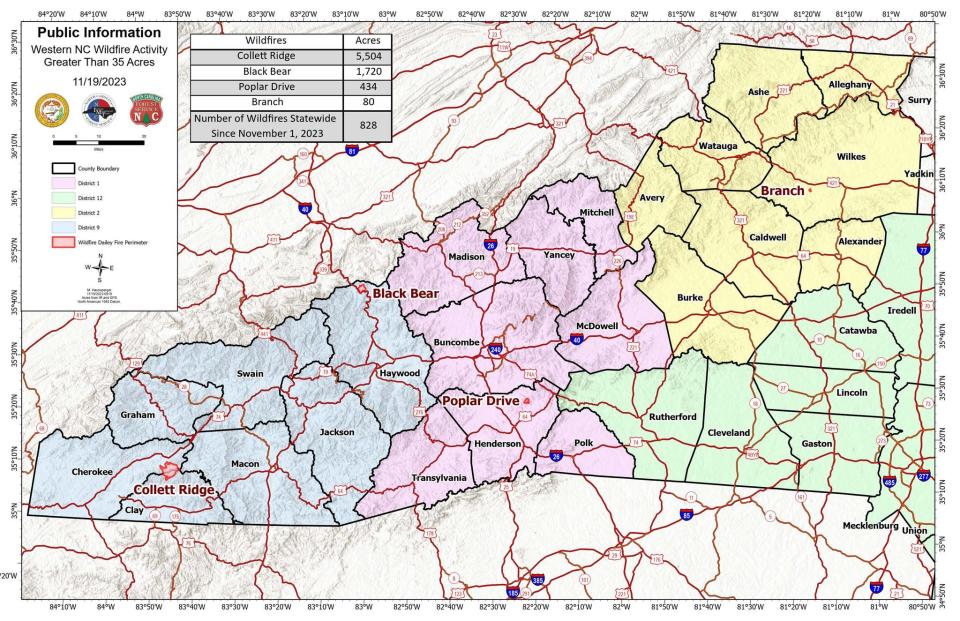Pisgah National Forest fire grows, Appalachian Trail still closed from I-40 to Max Patch
ASHEVILLE - A fire sparked by a traffic accident along Interstate 40 in Haywood County continues to grow, increasing about 44% in size overnight, according to a Nov. 19 news statement from the North Carolina Forest Incident Management Team.
The Black Bear Fire, which started Nov. 16, is now 1,720 acres and is 0% contained, is burning in Pisgah National Forest near the Tennessee border, but a rainstorm expected the night of Nov. 20 might go a long way toward tamping down the smoke and flames.
While I-40 remains open, drivers should expect delays from both directions, and might experience reduced visibility on I-40 due to fires in the area. For public and firefighter safety, the Appalachian Trail is closed from I-40 to Max Patch. Road closures are in effect for Cold Springs Road and Brown Gap Road. Check current road conditions at drivenc.gov. For more information on Black Bear fire, visit https://inciweb.nwcg.gov.

Primary containment lines have been identified around the Black Bear Fire, using I-40 on the southwest, the Appalachian Trail from I-40 to Groundhog Creek Shelter along the north, and Forest Road 3580 on the east, south to I-40, according to the U.S. Forest Service.
"Groundhog Creek drainage is being scouted as a better eastern containment line to further limit fire spread potential. Containment line work along the Appalachian Trail will consist of raking away forest floor litter and removing fallen trees, much like normal trail maintenance, to minimize impacts along the National Scenic Trail," according to the agency's Nov. 19 post.
Rain is expected to start in the Western North Carolina mountains around midnight Nov. 20, gradually increasing across the night into the day Nov. 21, then decreasing Tuesday night and ending Wednesday morning, according to Doug Outlaw, meteorologist with the National Weather Service, based in Greer, South Carolina.
The total amount of rain expected for Asheville is about an inch. Places further south including Hendersonville, should receive 1.5-2 inches of rain, and Brevard and Lake Toxaway will see from 1.5 to 3 inches, Outlaw said.
Along the Tennessee border, including Marshall, 3/4 of an inch to an inch are expected.
"All the fires should be extinguished by Tuesday night, I would think, with all this rain. At the very lease, firefighters should make a lot of progress and have everything under control," Outlaw said.
Answer Man Is Asheville at increased wildfire risk? How can we protect our homes?
State of emergency: North Carolina Gov. Roy Cooper declares state of emergency as wildfires burn in mountains
The rain forecast is a welcome relief from the drought that has been strangling much of Western North Carolina this fall. So far in November, the Asheville area has only received .15 of an inch so far, which is 2 inches below normal, Outlaw said.
Stronger winds from the southeast with gusts in excess of 30 mph can be expected at the highest peaks near the North Carolina-Tennessee border Monday evening. Other areas in the region are expected to see an increase in southerly winds on Tuesday with gusts in excess of 30 mph.
But since Jan. 1, the area is 12.64 inches below normal rainfall to his point in the year, which should be 43.82 inches by now, he said.
The Asheville area is in moderate drought, while other parts of Buncombe and Madison counties are in sever drought, and Henderson County is in extreme drought.
The next chance of rain after Tuesday is coming up on Saturday, Nov. 25. High temperatures on Monday and Tuesday will be about 50 degrees, then 52 on Wednesday and a high of about 57 is expected for Thanksgiving Day, though the morning of Nov. 23 will be about 30 degrees, Outlaw said.
Prison escapee in Jackson County: FBI: Prison escapee charged with child rape spotted in Sylva, Jackson County
Deer hunting season impacts?
Gun season for deer rifle starts Nov. 20 and lasts through Dec. 9 in WNC, in areas including Pisagh National Forest. During this time, bear hunting is in recess and starts again Dec. 11-Jan. 1. The U.S. Forest Service on its Facebook page Nov. 19 issued hunting safety announcements while firefighters remain in the area:
More: Chronic wasting disease detected in NC deer: what hunters need to know
Before pulling the trigger, know what is behind your target. Fire crews may be working in the area.
Even if the fires are not actively burning, there are still hot spots and potential for reburn that could be dangerous to anyone within the interior of a burned area.
New firelines may be popular ways to walk into hunting spots, but also heavy equipment may be working along these firelines. Avoid approaching heavy equipment while it is working because the operator may not see you.
Trees have been weakened by the fire and could fall, so be cautious around snags and damaged trees.
Update on other WNC fires
Poplar Drive Fire: The fire burning in Henderson County has reached 100% containment and will continue to be monitored by N.C. Forest Service personnel. The fire footprint was 434 acres, and the cause was determined to be a debris burn.
Collett Ridge Fire: Burning in Cherokee and Clay counties in the Nantahala National Forest, the fire is 5,505 acres and 82% contained. The Collett Ridge Fire, determined to be started by lightning strike, is being managed under unified command by the U.S. Forest Service and N.C. Forest Service. Information on this fire can be found at facebook.com/nfsnc/.

Fire totals: From Nov. 1-19, 828 fires have burned on state and private lands statewide, according to the N.C. Forest Service. Firefighters responded Nov. 18 to several small fires across the region, protecting more than 20 structures with an estimated total value over $100 million.
Burn ban notice: A burn ban was instated in 14 Western North Carolina counties Nov. 6 in response to severe drought conditions and multiple fires. On Nov. 8, the burn ban was expanded to an additional 16 counties amid persisting drought conditions and fires, with Gov. Roy Cooper declaring a state of emergency on Nov. 9.
The Blue Ridge Parkway has banned backcountry campfires, while the Great Smoky Mountains National Park has banned all campfires and charcoal use throughout the park. Backcountry campsites are closed in nine N.C. state parks. See a map of fires burning across Western North Carolina at https://data.citizen-times.com/fires.
For fire updates, visit https://www.ncforestservice.gov/fire_control/sit_report.htm or follow the N.C. Forest Service on Facebook at https://www.facebook.com/NCForestService.
This article originally appeared on Asheville Citizen Times: Pisgah National Forest Black Bear Fire grows near Appalachian Trail

